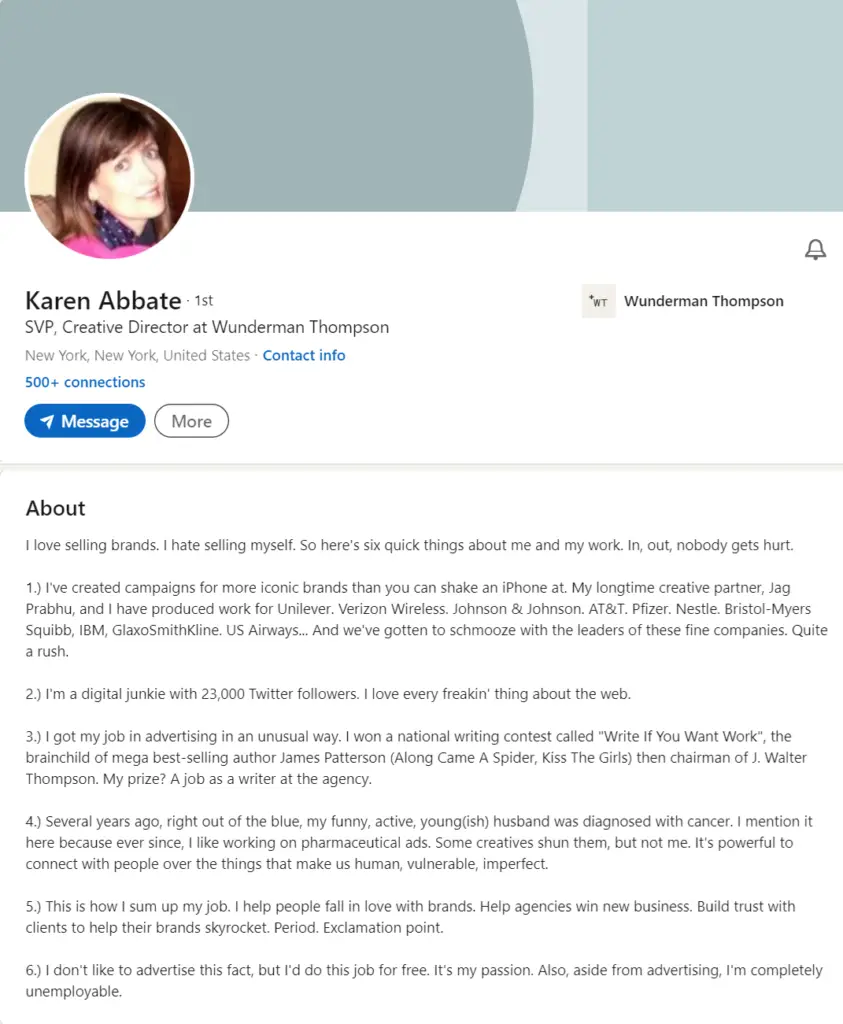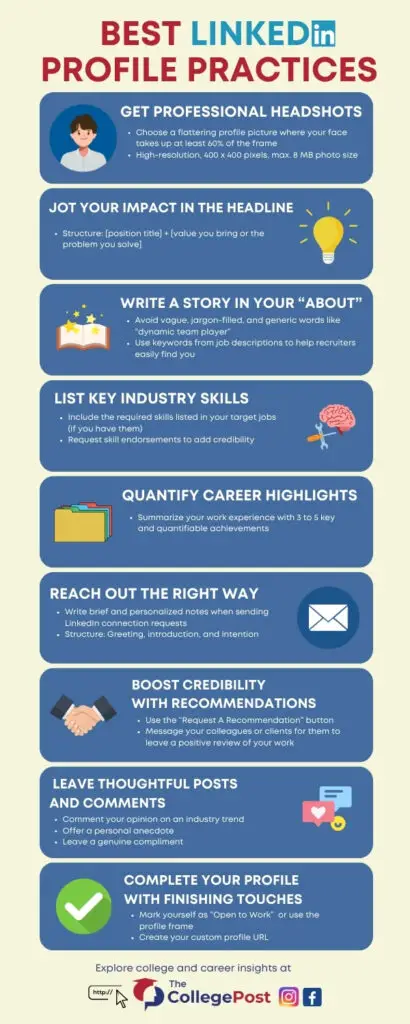There’s a way to multiply your job-hunting productivity aside from creating a spectacular resume: an optimized LinkedIn profile.
LinkedIn is a digital advertising board of your skills and work experience. When done right, attracting potential employers and building a professional network can be done in your sleep. 🤩
So, how do you do it right? Here are the 10 top tips to make your LinkedIn stand out from a thousand others. 💯
- 1. Invest in Professional Headshots for Your Profile
- 2. Highlight the Value You Can Bring to Employers
- 3. Show (Don’t Tell) Your Strengths in the “About” Section
- 4. Play up Key Skills in Your Target Industry
- 5. Share the Specifics of Your Work Experience
- 6. Reach Out the Right Way
- 7. Boost Your Credibility With Recommendations
- 8. Leave Thoughtful Posts and Comments
- 9. Mark Yourself as “Open To Work”
- 10. Create a Custom URL for Your Profile
- Bonus Tip: How to Find Jobs on LinkedIn
- Ways to Make Your LinkedIn Stand Out: Frequently Asked Questions
1. Invest in Professional Headshots for Your Profile

Think of the LinkedIn profile picture as your potential employer’s first impression of you. To make a statement right off the bat, choose a professional yet flattering self-portrait. 🖼️
Refrain from leaving it empty to avoid mistaken identities and possiby missing out on job opportunities.
TIP: Get a professional photographer to ensure the best profile photo quality. The goal is a high-resolution image with 400 x 400 pixels, where your face takes up at least 60 percent of the frame and a maximum 8 MB photo file size. 📸
There’s also the LinkedIn banner which acts as a business card. It should show your contact details or hint at your personality or hobbies (perfect for interview icebreakers) — and there are free LinkedIn Banner templates on Canva. 💯
2. Highlight the Value You Can Bring to Employers

Add a convincing elevator pitch (your quick and concise background) in the LinkedIn Headline (the line of text below your name) because recruiters spend an average of around one minute per profile.
Fill the headline’s 220-character limit with your position title, the value you bring with your skills, and keywords relevant to your current role. ✍️
TIP: Break down corporate-speak into plain and specific language: “Implement a cost-paradigm shift to optimize operational efficiency and achieve a competitive edge in the market.” becomes “Use smart tools to beat the competition.”
You can always elaborate on the specifics in your “About” or “Experience” section.
Using generic labels, like “Software Engineer”, buries your profile under thousands who share the same job. Add a concise phrase of exactly what you do in your role, like “Software Engineer @ XYZ | Building B2B Sales Apps for Lightning-Fast Performance,” to amp it up.⚡
READ MORE: 25 Best Computer Science Colleges to Get You Tech Success
3. Show (Don’t Tell) Your Strengths in the “About” Section

The “About” section is a premium location to show profile visitors what you have to offer. Avoid vague, jargon-filled essays that make you sound generic (i.e., using phrases like “highly motivated professional” and “dynamic team player”).
Instead, write a short but engaging story detailing your career. Remember to sprinkle it with specific words or phrases commonly used in the job descriptions you’ve been eyeing. 👀
TIP: High-volume keywords help recruiters find your profile. Using them also demonstrates that you possess the qualifications they want in a candidate.
Upload the keywords in a free word cloud to generate frequently used variations of these terms that can be inserted wherever possible throughout your LinkedIn profile.
Instead of the plain ol’ stating your name and experience, add a little oomph. Advertise your personality and values, as well as your proudest achievements, with quantifiable data, then end with a call to action. ✍️
Good to know: LinkedIn’s “About” section shows the first three lines before profile viewers must click the “See More” option.
So, open with an attention-grabbing statement, like an anecdotal hook based on the one thing you want people to know about you. Let’s use the software engineer example here:
- “It’s your common origin story: I was a nerd back in high school and pursued computer science in college. But, how I became a project manager is another story.”
- “Imagine a code writer who moves faster than a startup on its fifth espresso shot. Yup, that’s me — and how I became that kind of tech geek was kind of an accident.”
- “I caught the coding bug. It was the summertime of my high school junior year…”
Still stumped for ideas? Check out a few of the best examples from LinkedIn:
Shanay Smith describes what she does while leading with intrigue: “I’m the colleague at work that everyone wants to know but nobody wants to be.”
She proceeds to give readers a glimpse into her personality and values and how these relate to her profession. Lastly, she gives a call to action, tying everything together while inviting the reader to connect with her. 😊
However, you don’t always have to expound on the details of your career to date like that. You can follow the example of Sally Liang, who keeps the section short and sweet.
In three paragraphs, you’re introduced to her background and how it influenced her career choice, along with her hobbies that become a good icebreaker. She also shows her approachability with the way she ended this section. 🤝
If you prefer to dive into the details of your accomplishments, you can jot them down in bullet points or weave them into a numbered list like Karen Abbate.

Her quick one-liners in the first paragraph let you know what she does while hooking you in. 👀 Then, she shares anecdotes and sprinkles data about her background, interests, and accomplishments — all related to her career.
Those three examples are just a few out of many LinkedIn summaries to give you a creative and strategic idea on how to frame your quick answer to the question: “Tell me about yourself.” 👍
4. Play up Key Skills in Your Target Industry

Common essential job skills, like time management, may be easier to pick up but specialized ones give you an edge over other candidates.
Search your target jobs on LinkedIn and add the unique skills to your profile — but only if you really have them. You can even receive skill endorsements from first-degree connections, aka people you’ve worked with directly, to add credibility. ✅
TIP: Take LinkedIn’s Skill Assessment Test to boost your profile on the platform’s search results page. 💪
It’s possible to list around 50 skills on your profile, but highlight those that are relevant to the job you’re searching for as your top five.
5. Share the Specifics of Your Work Experience

Think like a recruiter skimming hundreds of candidate profiles with similar work histories. What is the best thing that a prospect can do for you?
There’s nothing better than when you immediately give a concise overview of your experience paired with three to five specific achievements explaining why you’re the best fit. 😄
Make sure to simplify and tighten up your sentences while including quantifiable data and keywords.
💡 An example of work experience for a marketing assistant:
Turn “I assisted with tasks for different social media campaigns” into “I helped increase the company’s Instagram engagement rate by 20 percent in a three-month period using a targeted hashtag strategy.”
Adding profile sections to complement your background helps recruiters know your capabilities in a snap, like your volunteer experience, honors and awards, and languages spoken. 👌
Good to know: If you’ve been on a career break, LinkedIn offers a feature that can help you add to your profile a description of your activities during your time away from work.
6. Reach Out the Right Way

Landing a job is also about who you know, not only what you know. LinkedIn can bridge you with people from your alumni network or even past careers to expand your online network.
That can come in handy when you need skill endorsements, recommendations, or hearing industry news or a new job opening. 🤝
Make the first move with a brief personalized note — this option shows up when you ask to connect — stating your identity and intention. Once accepted, you’ll see your new connection’s newsfeed updates, and you’re able to message them anytime. ✉️
TIP: You need a premium LinkedIn account to message non-connections. But, there’s a way around that: join the same groups as your target profiles because members of the same group can message each other for free.
7. Boost Your Credibility With Recommendations

Which one are you more likely to buy: a product from brand A with five positive reviews or one from brand B with no reviews at all? 🛒
Just as you’d likely go for the first option, recruiters look more favorably toward LinkedIn profiles with recommendations. It’s good to show your skills and portfolio but also have proof of your capabilities in the form of recommendations posted on your LinkedIn profile. 💬
Use the “Request A Recommendation” button or message your colleagues or clients for them to leave a positive review of your work.
TIP: Prepare a template where your colleagues can fill in the blanks or reciprocate the favor by writing them recommendations in return. 😄
8. Leave Thoughtful Posts and Comments

Your LinkedIn profile is your personal brand where every single detail and action on the platform must support the image you promote.
It’s best to be intentional and professional with what you do since your “Activity” section shows your recent posts and profile updates. 👀
Instead of writing generic comments on posts like, “Thanks for sharing this!”, give a unique takeaway. You can add your take on a trend within your industry, offer a personal anecdote that can start a discussion, or leave a genuine compliment. 🤔
9. Mark Yourself as “Open To Work”
LinkedIn is more than a job search platform; it’s where companies also seek new hires. Activate your “Open to work” status to enhance your visibility to recruiters. ✅
To set this up, click “Open to” then “Finding a job” in your bio and choose your top five job titles, and specify your preferred working conditions: job type, (on-site, hybrid, or remote), location, start date, and employment type. 👍
Good to know: You can make your job-seeking status visible to LinkedIn Recruiter users, but it may still be seen by your current employer. Alternatively, using the “Open to Work” frame signals to everyone that you’re seeking employment. Just make sure your profile highlights the value you bring. 💯
10. Create a Custom URL for Your Profile
It’s common practice for recruiters to search for you on Google. This means that you want your now-optimized LinkedIn profile to top the search results page. 🔝
Go to the top right corner of your profile and click “Public Profile & URL.” Type in your first and last name in the blank. Once you’re done, you can copy your customized URL and paste it on your resume, too. 📄
TIP: Got a not-so-common name? Use the “Name Pronunciation” feature via LinkedIn’s iOS or Android mobile app to display the audio option right beside your name.

Bonus Tip: How to Find Jobs on LinkedIn
Many job hunters on LinkedIn find available posts by enabling job alerts or freely checking out the “Jobs” section. This may work, but there are plenty of ways to expand these opportunities.
- Follow the thought leaders in your industry. 🏆 They regularly post content that can give you insight into the latest trends and may give you a lead toward someone who’s hiring via a LinkedIn status update.
- LinkedIn also has a new feature you can use: visit the “About” tab of your target company’s page and find the “Interested in working with us in the future?” section. Click the “I’m Interested” button so recruiters can prioritize viewing your profile as an interested candidate for up to a year. 📅
- Using target keywords and filters can lead you to active recruiters who are likely to be more receptive to applicants reaching out. In the search bar, type “hiring” “[role/position]” and narrow your search by location, industry, and other filters. 🔍
READ MORE: The 21 Top Jobs for College Graduates (and How to Get Hired!)
Applying the tips above on how to make your LinkedIn stand out can turn your job-hunting from torture to a joyride of productivity. After all, a professional LinkedIn profile that meets what recruiters look for is a win-win situation for everyone. 💯
Ways to Make Your LinkedIn Stand Out: Frequently Asked Questions
What is LinkedIn?
LinkedIn is a social networking site for professionals, such as companies, job-seekers, recruiters, and businesspeople to connect, build personal brands, promote work portfolios, post and apply for jobs, and share career or industry knowledge.
What can you do with a LinkedIn profile?
Your LinkedIn profile acts as a digital advertisement of your personal brand and overall professional career experience. A complete profile helps you connect with like-minded people in your industry or boost your chances of getting seen and hired by recruiters.
How do you reach out to a recruiter via LinkedIn?
First, make sure you have a complete LinkedIn profile. Then, message recruiters with a brief but personalized note: start with warm greetings, note any similarities to establish a connection, and state your reason for connecting with them. Keep your initial message simple and professional.
How do you create LinkedIn posts?
Go to the “Activity” section and click the “Create a post” button. Keep your message intentional and easy-to-understand for your target audience.
What metrics are important in LinkedIn?
These are the important LinkedIn metrics for job-seekers:
- Time spent on pre-job activities (research, resume creation, completing job applications, messaging connections and recruiters, and preparing for job interviews)
- Number of applications and response rates
- Quality of your job application
- Number of job interviews you take
- Number of job offers you get


